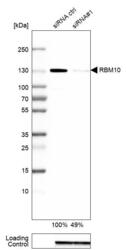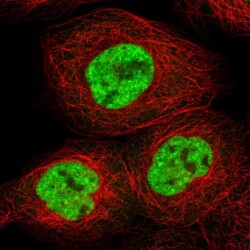HPA034972
antibody from Atlas Antibodies
Targeting: RBM10
DXS8237E, GPATC9, GPATCH9, KIAA0122, S1-1, ZRANB5
Antibody data
- Antibody Data
- Antigen structure
- References [10]
- Comments [0]
- Validations
- Western blot [1]
- Immunocytochemistry [1]
Submit
Validation data
Reference
Comment
Report error
- Product number
- HPA034972 - Provider product page

- Provider
- Atlas Antibodies
- Proper citation
- Atlas Antibodies Cat#HPA034972, RRID:AB_10602919
- Product name
- Anti-RBM10
- Antibody type
- Polyclonal
- Description
- Polyclonal Antibody against Human RBM10, Gene description: RNA binding motif protein 10, Alternative Gene Names: DXS8237E, GPATC9, GPATCH9, KIAA0122, ZRANB5, Validated applications: ICC, IHC, WB, Uniprot ID: P98175, Storage: Store at +4°C for short term storage. Long time storage is recommended at -20°C.
- Reactivity
- Human
- Host
- Rabbit
- Conjugate
- Unconjugated
- Isotype
- IgG
- Vial size
- 100 µl
- Concentration
- 0.5 mg/ml
- Storage
- Store at +4°C for short term storage. Long time storage is recommended at -20°C.
- Handling
- The antibody solution should be gently mixed before use.
Submitted references Harnessing DNA replication stress to target RBM10 deficiency in lung adenocarcinoma
Impact of RBM10 and PD-L1 expression on the prognosis of pathologic N1–N2 epidermal growth factor receptor mutant lung adenocarcinoma
RNA Binding Motif 5 Gene Deletion Modulates Cell Signaling in a Sex-Dependent Manner but Not Hippocampal Cell Death
RNA binding motif protein 10 suppresses lung cancer progression by controlling alternative splicing of eukaryotic translation initiation factor 4H
Dengue virus targets RBM10 deregulating host cell splicing and innate immune response
Functional analysis reveals that RBM10 mutations contribute to lung adenocarcinoma pathogenesis by deregulating splicing
Autoregulation of RBM10 and cross-regulation of RBM10/RBM5 via alternative splicing-coupled nonsense-mediated decay
RBM10 promotes transformation-associated processes in small cell lung cancer and is directly regulated by RBM5
The nuclear splicing factor RNA binding motif 5 promotes caspase activation in human neuronal cells, and increases after traumatic brain injury in mice.
Machour F, R. Abu-Zhayia E, Kamar J, Barisaac A, Simon I, Ayoub N
Nature Communications 2024;15(1)
Nature Communications 2024;15(1)
Krishnamoorthy G, Glover A, Untch B, Sigcha-Coello N, Xu B, Vukel D, Liu Y, Tiedje V, Berman K, Tamarapu P, Acuña-Ruiz A, Saqcena M, de Stanchina E, Boucai L, Ghossein R, Knauf J, Abdel-Wahab O, Bradley R, Fagin J
2024
2024
Impact of RBM10 and PD-L1 expression on the prognosis of pathologic N1–N2 epidermal growth factor receptor mutant lung adenocarcinoma
Isaka T, Miyagi Y, Yokose T, Saito H, Kasajima R, Watabe K, Shigeta N, Kikunishi N, Shigefuku S, Murakami K, Adachi H, Nagashima T, Ito H
Translational Lung Cancer Research 2023;12(10):2001-2014
Translational Lung Cancer Research 2023;12(10):2001-2014
RNA Binding Motif 5 Gene Deletion Modulates Cell Signaling in a Sex-Dependent Manner but Not Hippocampal Cell Death
Farooq J, Snyder K, Janesko-Feldman K, Gorse K, Vagni V, Kochanek P, Jackson T
Journal of Neurotrauma 2022;39(7-8):577-589
Journal of Neurotrauma 2022;39(7-8):577-589
RNA binding motif protein 10 suppresses lung cancer progression by controlling alternative splicing of eukaryotic translation initiation factor 4H
Zhang S, Bao Y, Shen X, Pan Y, Sun Y, Xiao M, Chen K, Wei H, Zuo J, Saffen D, Zong W, Sun Y, Wang Z, Wang Y
EBioMedicine 2020;61
EBioMedicine 2020;61
Dengue virus targets RBM10 deregulating host cell splicing and innate immune response
Srebrow A, Gamarnik A, García C, Iglesias N, Vaz-Drago R, García Solá M, Gebhard L, Gaioli N, Torti M, Mammi P, Bragado L, Pozzi B
Nucleic Acids Research 2020;48(12):6824-6838
Nucleic Acids Research 2020;48(12):6824-6838
Functional analysis reveals that RBM10 mutations contribute to lung adenocarcinoma pathogenesis by deregulating splicing
Zhao J, Sun Y, Huang Y, Song F, Huang Z, Bao Y, Zuo J, Saffen D, Shao Z, Liu W, Wang Y
Scientific Reports 2017;7(1)
Scientific Reports 2017;7(1)
Autoregulation of RBM10 and cross-regulation of RBM10/RBM5 via alternative splicing-coupled nonsense-mediated decay
Sun Y, Bao Y, Han W, Song F, Shen X, Zhao J, Zuo J, Saffen D, Chen W, Wang Z, You X, Wang Y
Nucleic Acids Research 2017;45(14):8524-8540
Nucleic Acids Research 2017;45(14):8524-8540
RBM10 promotes transformation-associated processes in small cell lung cancer and is directly regulated by RBM5
Ahmad A, Loiselle J, Roy J, Sutherland L
PLOS ONE 2017;12(6):e0180258
PLOS ONE 2017;12(6):e0180258
The nuclear splicing factor RNA binding motif 5 promotes caspase activation in human neuronal cells, and increases after traumatic brain injury in mice.
Jackson TC, Du L, Janesko-Feldman K, Vagni VA, Dezfulian C, Poloyac SM, Jackson EK, Clark RS, Kochanek PM
Journal of cerebral blood flow and metabolism : official journal of the International Society of Cerebral Blood Flow and Metabolism 2015 Mar 31;35(4):655-66
Journal of cerebral blood flow and metabolism : official journal of the International Society of Cerebral Blood Flow and Metabolism 2015 Mar 31;35(4):655-66
No comments: Submit comment
Enhanced validation
- Submitted by
- Atlas Antibodies (provider)
- Enhanced method
- Genetic validation
- Main image

- Experimental details
- Western blot analysis in A-549 cells transfected with control siRNA, target specific siRNA probe #1, using Anti-RBM10 antibody. Remaining relative intensity is presented. Loading control: Anti-GAPDH.
- Sample type
- Human
- Protocol
- Protocol
Supportive validation
- Submitted by
- Atlas Antibodies (provider)
- Main image

- Experimental details
- Immunofluorescent staining of human cell line A-431 shows localization to nuclear speckles.
- Sample type
- Human
 Explore
Explore Validate
Validate Learn
Learn Western blot
Western blot Immunocytochemistry
Immunocytochemistry Immunohistochemistry
Immunohistochemistry